LAB REPORT
Science and Technology Making Headlines
Feb. 9, 2018

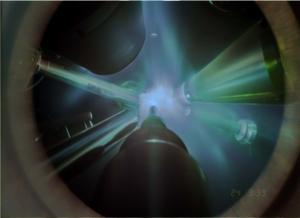
Time-integrated image of a laser-driven shock compression experiment to recreate planetary interior conditions and study the properties of superionic water. Image by M. Millot/E. Kowaluk/J.Wickboldt/LLNL/LLE/NIF
As cold as ice
Scientists have confirmed a form of water that is simultaneously solid and liquid. It is the latest advance in the study of water, a seemingly simple substance that can shift between many different configurations.
“That’s a really strange state of matter,” said Marius Millot, a physicist at Lawrence Livermore, the lead author of a paper published in the journal Nature Physics that describes the experiments.
This new form, called superionic ice, consists of a rigid lattice of oxygen atoms through which positively charged hydrogen nuclei move. It is not known to exist naturally anywhere on Earth, but it may be bountiful farther out in the solar system, including in the mantles of Uranus and Neptune.

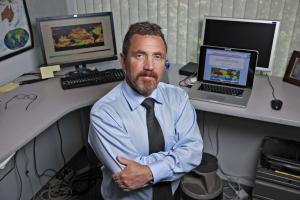
LLNL climate scientist Ben Santer. Credit Everett Collection Inc./Alamy Stock Photo
This history is in the fingerprints
Climate models lay at the heart of the world’s understanding of the changing climate. Scientists use models to project how these changes might continue to play out in the decades ahead.
Today’s cutting-edge models are very different to the first ones sketched out on paper almost a century ago.
Carbon Brief lists 50 key moments in the development of climate models and LLNL’s Ben Santer’s work in “fingerprinting” lands a spot in 1996. Santer wrote an influential paper that showed that the most up-to-date climate models match the observed spatial patterns of temperature change in the free atmosphere from 1963-1987, when various combinations of changes in greenhouse gases and aerosols are added.

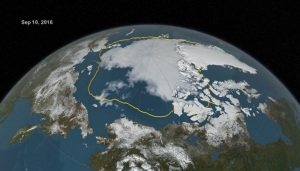
Extent of Arctic sea ice in September 2016 versus the 1981-2010 average minimum extent (gold line). Through satellite images, researchers have observed a steep decline in the average extent of Arctic sea ice for every month of the year. Image courtesy of NASA.
California could become bone dry
Scientists are warning that climate adaptation is critical to deal with the inevitable changes as the world heats.
On top of temperature rise, California is increasingly at risk from severe drought, according to Lawrence Livermore researchers. They’ve discovered a link between the retreat of Arctic sea ice and a decline in rainfall in the Golden State.
And more droughts could be on the way. The team said that the steady attrition of sea ice in the Arctic Ocean triggers a change in atmospheric convection over the tropical Pacific, which creates the right conditions for an atmospheric ridge over the North Pacific, which means California gets a lot sunnier, and therefore drier.

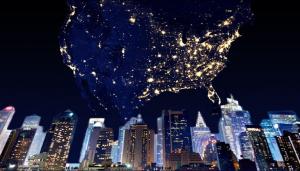
A new project led by Lawrence Livermore researchers plans to use distributed energy resources, such as customer-generated solar power, to enhance the electrical grid's ability to recover from a blackout or cascading outage quickly in the event of a major disaster.
Jumpstarting the dark grid
Distributed power may be the key to recovery from a massive blackout. A new project headed by Lawrence Livermore aims to use microgrid resources to boost the electric grid’s ability to bounce back more rapidly from blackouts or cascading outages, such as those following major storms or earthquakes.
In less than three years, researchers will attempt to demonstrate the potential of distributed energy resources, including the energy produced by solar panels on homes, to help restore power to the grid from scratch, an effort commonly known as a black start. The black start process is now done manually using special generators that can provide power to slowly bring other generators back online.
This normally takes days, but by using a distributed energy resource management system (DERMS) being developed under the research lab’s CleanstartDERMS project, the process may be reduced to about four hours. In addition to improving customer reconnection time, a smarter, more robust and selective communication and control system could reduce grid recovery costs.

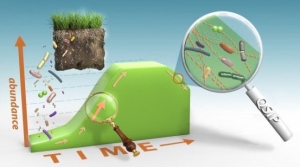
Northern Arizona State University and Lawrence Livermore researchers have developed a technique to measure the growth rates of hundreds of co-occurring individual microbial taxa simultaneously within their natural environment. Credit: Victor Leshyk, NAU
Which microbe matters most
Scientists from Northern Arizona University, in collaboration with Lawrence Livermore’s Steven Blazewicz and Jennifer Pett-Ridge, have demonstrated a powerful new technique to simultaneously measure the growth rates of hundreds of individual bacterial taxa in any given soil sample.
Measuring the rate at which each microbe grows within an environmental sample is fundamental to understanding which organisms play the most important roles in natural and engineered environments that matter most to people, such as natural and agricultural soils, lakes and streams and the human microbiome.
This new measurement technique is based on quantitative stable isotope probing. By adding rare stable isotopes to soil -- tracers that contain heavy oxygen -- and then sequencing the bacteria that incorporated that tracer, the scientists were able to estimate growth, mortality and turnover rates for individual microbial populations within soil samples.





